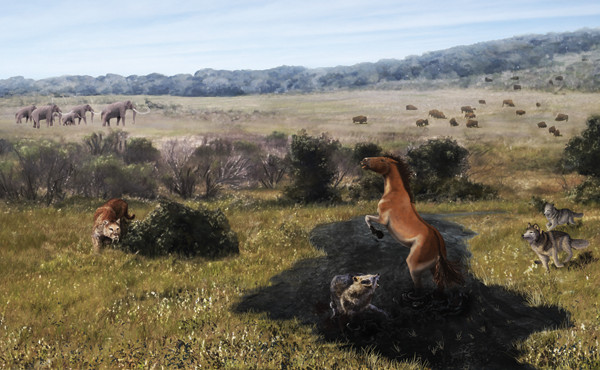
by Mary Caperton Morton Tuesday, October 15, 2013

Kathleen Cantner, AGI
The La Brea tar pits in the middle of Los Angeles are known for turning up spectacularly preserved specimens of dire wolves, saber-tooth cats and woolly mammoths. But how long it took for the animals to sink down into the sticky tar after they became trapped has long been a mystery. Now a new study looking at the traces left by hungry bone-eating insects is providing a minimum time span for burial, as well as confirming some long-held suspicions about when the tar pits were at their most lethal.
Unlike most fossil quarries, the La Brea tar pits are still an active hazard. “Working at the tar pits, at some point you’re going to step in a tar seep. It’s almost a rite of passage,” says Anna Holden, a paleoentomologist at the Natural History Museum of Los Angeles County in California and lead author of the new study, published in PLOS ONE.
At La Brea, heavy oil fractions of asphaltum seep up from the Salt Lake Oil Field, which has been active for tens of thousands of years. As little as four centimeters of tar could be enough to ensnare a large animal, Holden says. If the struggling animal attracted opportunistic carnivores, some of those might have gotten stuck too. Over thousands of years, the tar pits have swallowed up countless animals, accounting for the epic fossil collection at the onsite George C. Page Museum, part of the Natural History Museum of Los Angeles County.
Some of these fossils — specifically the lower leg and foot bones of juvenile herbivores — show distinct chew marks from insects, which must have been left on the bones after the animals died but before they were completely submerged in the tar. By studying the life cycles of the insects that left the trace marks, Holden and colleagues determined how long the trapped animals must have remained on the surface of the tar, before sinking into the pits.
But first they had to determine what kinds of insects left the chew marks. Since many of the insect species found fossilized in the tar pits are still alive today, “the best way to do this is to have live insect colonies nibble on bones and compare the marks left by living beetles with the trace fossils,” Holden says. Like a CSI case, by feeding bones to colonies of different types of beetle larvae, they determined that the majority of the traces had been left by the larval stage of dermestid and tenebrionid beetles, as well as a third, as-yet unidentified species.
“It’s kind of surprising to find out what kinds of insects did this damage to the bones because these beetles are still crawling all over Southern California,” says Blaire Van Valkenburgh, a paleobiologist at UCLA who was not involved in the new study.
Holden and her team studied thousands of fossils. With very few exceptions, the insect damage seemed to be confined to the lower leg and foot bones of juvenile herbivores. “The foot bones of juveniles tend to be very spongy and vascular, which would have been an ideal feeding environment for larvae, and herbivore hides tend to mummify in the heat and sun, which leaves a subcutaneous environment that has all the ingredients that beetle eggs and larvae need,” Holden says.
Once they hatched, the larvae fed on the remains, including the bones. Given the life cycle of dermestids and tenebrionids, Holden and colleagues determined that the carcasses must have remained on the surface of the tar for at least 17 to 20 weeks.
“To my knowledge, this is the first systematic study of insect traces at the tar pits,” Van Valkenburgh says. “I’ve been shown traces from time to time when visiting the [fossil] collection, but nobody had identified what kinds of insects had done the damage.”
The presence of dermestids and tenebrionids, both warm-weather beetles, helps confirm some suspicions about when the tar pits were most likely to ensnare animals. “The probability of entrapment likely varied with temperature in a predictable way,” Van Valkenburgh says. “These bugs are associated with warmer climates, and when it’s warm, the tar is stickier and things are more easily trapped.”
The tar pits are well studied, but there are a number of outstanding questions that might be answered by focusing more on the tiniest insect trace fossils, Holden says. “Traces seem obscure at a glance, but they can be very revealing.” For example, trace fossils left by leaf-cutter bees and gall wasps may reveal valuable information about the kinds of plants that grew around the tar pits. “The saber-tooth cats and mammoths tend to get a lot of attention,” Holden says. “But I think insect traces might turn out to be one of the best available tools for studying this ecosystem.”
© 2008-2021. All rights reserved. Any copying, redistribution or retransmission of any of the contents of this service without the expressed written permission of the American Geosciences Institute is expressly prohibited. Click here for all copyright requests.